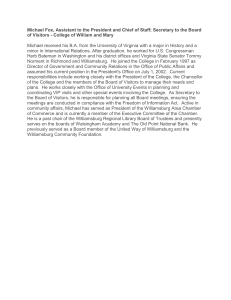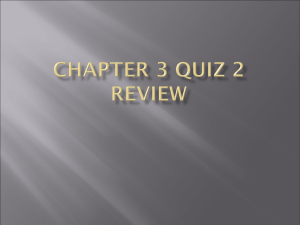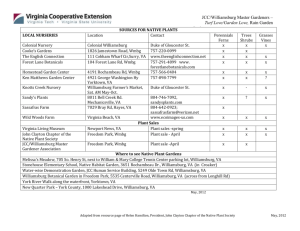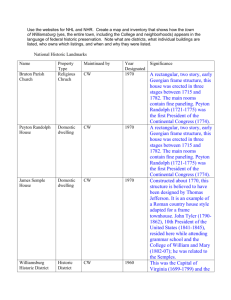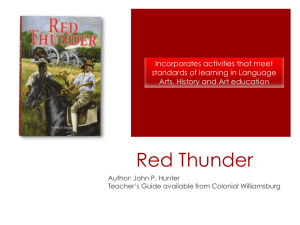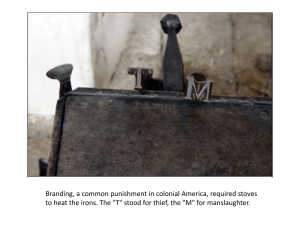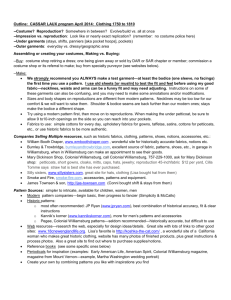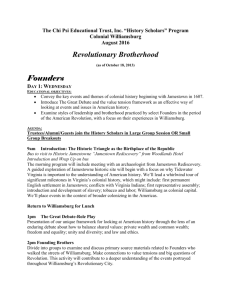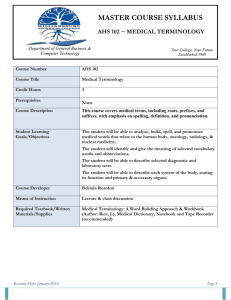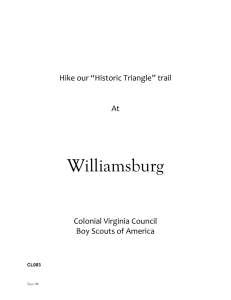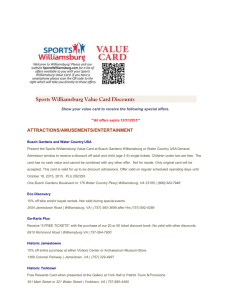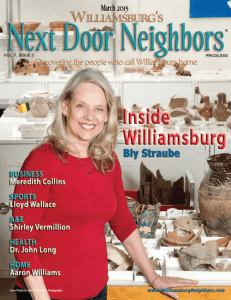Williamsburg Assignment - Sultana Education Foundation
advertisement
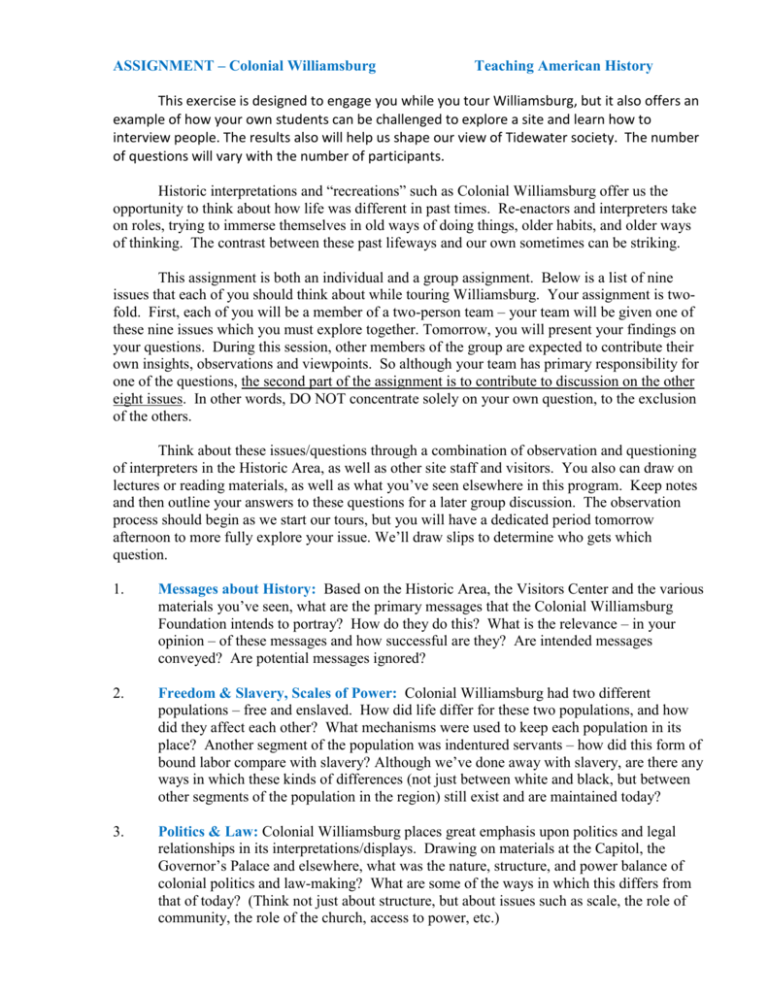
ASSIGNMENT – Colonial Williamsburg Teaching American History This exercise is designed to engage you while you tour Williamsburg, but it also offers an example of how your own students can be challenged to explore a site and learn how to interview people. The results also will help us shape our view of Tidewater society. The number of questions will vary with the number of participants. Historic interpretations and “recreations” such as Colonial Williamsburg offer us the opportunity to think about how life was different in past times. Re-enactors and interpreters take on roles, trying to immerse themselves in old ways of doing things, older habits, and older ways of thinking. The contrast between these past lifeways and our own sometimes can be striking. This assignment is both an individual and a group assignment. Below is a list of nine issues that each of you should think about while touring Williamsburg. Your assignment is twofold. First, each of you will be a member of a two-person team – your team will be given one of these nine issues which you must explore together. Tomorrow, you will present your findings on your questions. During this session, other members of the group are expected to contribute their own insights, observations and viewpoints. So although your team has primary responsibility for one of the questions, the second part of the assignment is to contribute to discussion on the other eight issues. In other words, DO NOT concentrate solely on your own question, to the exclusion of the others. Think about these issues/questions through a combination of observation and questioning of interpreters in the Historic Area, as well as other site staff and visitors. You also can draw on lectures or reading materials, as well as what you’ve seen elsewhere in this program. Keep notes and then outline your answers to these questions for a later group discussion. The observation process should begin as we start our tours, but you will have a dedicated period tomorrow afternoon to more fully explore your issue. We’ll draw slips to determine who gets which question. 1. Messages about History: Based on the Historic Area, the Visitors Center and the various materials you’ve seen, what are the primary messages that the Colonial Williamsburg Foundation intends to portray? How do they do this? What is the relevance – in your opinion – of these messages and how successful are they? Are intended messages conveyed? Are potential messages ignored? 2. Freedom & Slavery, Scales of Power: Colonial Williamsburg had two different populations – free and enslaved. How did life differ for these two populations, and how did they affect each other? What mechanisms were used to keep each population in its place? Another segment of the population was indentured servants – how did this form of bound labor compare with slavery? Although we’ve done away with slavery, are there any ways in which these kinds of differences (not just between white and black, but between other segments of the population in the region) still exist and are maintained today? 3. Politics & Law: Colonial Williamsburg places great emphasis upon politics and legal relationships in its interpretations/displays. Drawing on materials at the Capitol, the Governor’s Palace and elsewhere, what was the nature, structure, and power balance of colonial politics and law-making? What are some of the ways in which this differs from that of today? (Think not just about structure, but about issues such as scale, the role of community, the role of the church, access to power, etc.) 4. Trades, Crafts – Social & Environmental Impact: Various crafts and trades are on display in the Historic Area of Williamsburg. Many of these trades use various materials to create or transform objects. Thinking about and observing both the process of “making things” and the origin of the materials used, what is the impact of these trades on society and the environment, either here or elsewhere in the region? Which of the trades do you think had the greatest impacts on society and the environment, and what would those impacts be? How do these impacts compare with those of some of the trades/crafts that are practiced in our region today? 5. Art & Ideology: Art, including painting and many other forms of material culture (such as architecture, furniture, pottery, and more) often reflects the world view and ideology of a people. Looking at these elements in 18th C. Virginia, what kinds of insights can you glean about the people who lived in Williamsburg? In particular, how did they view nature, the world around them, and their place in that world? Give some concrete examples from the Historic Area or our other travels. 6. Music & Ideology: Music can take many forms, and it can offer powerful insights into how people think. You have heard a variety of music on your visit to Williamsburg – what kinds have you heard? What kinds of insights can you glean about the people who lived in Williamsburg, based on what you have heard? In particular, how might the music you hear reflect their views of nature, the world around them, and their place in that world? Give some concrete examples from the Historic Area or our other travels. 7. Foodways & Culture: Foods and the way people prepare and eat them (“foodways”) vary dramatically across time and culture. Foodways often reflect the environment in which a people live, as well as their technoeconomic system. Characterize the foodways on display in Williamsburg, and explore how they differ among different parts of the population. What do they tell us about the economy of this region? How do foodways reflect colonial Virginians’ views of nature, the world around them, and their place in that world? Give some concrete examples from the Historic Area or our other travels. Other questions to think about: Fences, People & Landscape: Explore Williamsburg’s fences – where are they, what are they made of, what do they do – and why? What do they tell us about the relationship of people with their landscape? How did these concepts change over time during the colonial period, and how do they differ from attitudes of today? (You can also find various laws written concerning fences in colonial Virginia.) Weather: To what extent were people of the 18th C. dependent upon or impacted by the weather in ways that are different from today? Think not just about town people, but also about farmers and sailors. What aspects of this relationship have you observed in Williamsburg and other sites we’ve visited? How and to what extent would such factors shape the way you think (or even care) about weather and – in a larger sense - nature? Contrast this with today and discuss any implications this may have for human-environmental interactions.
